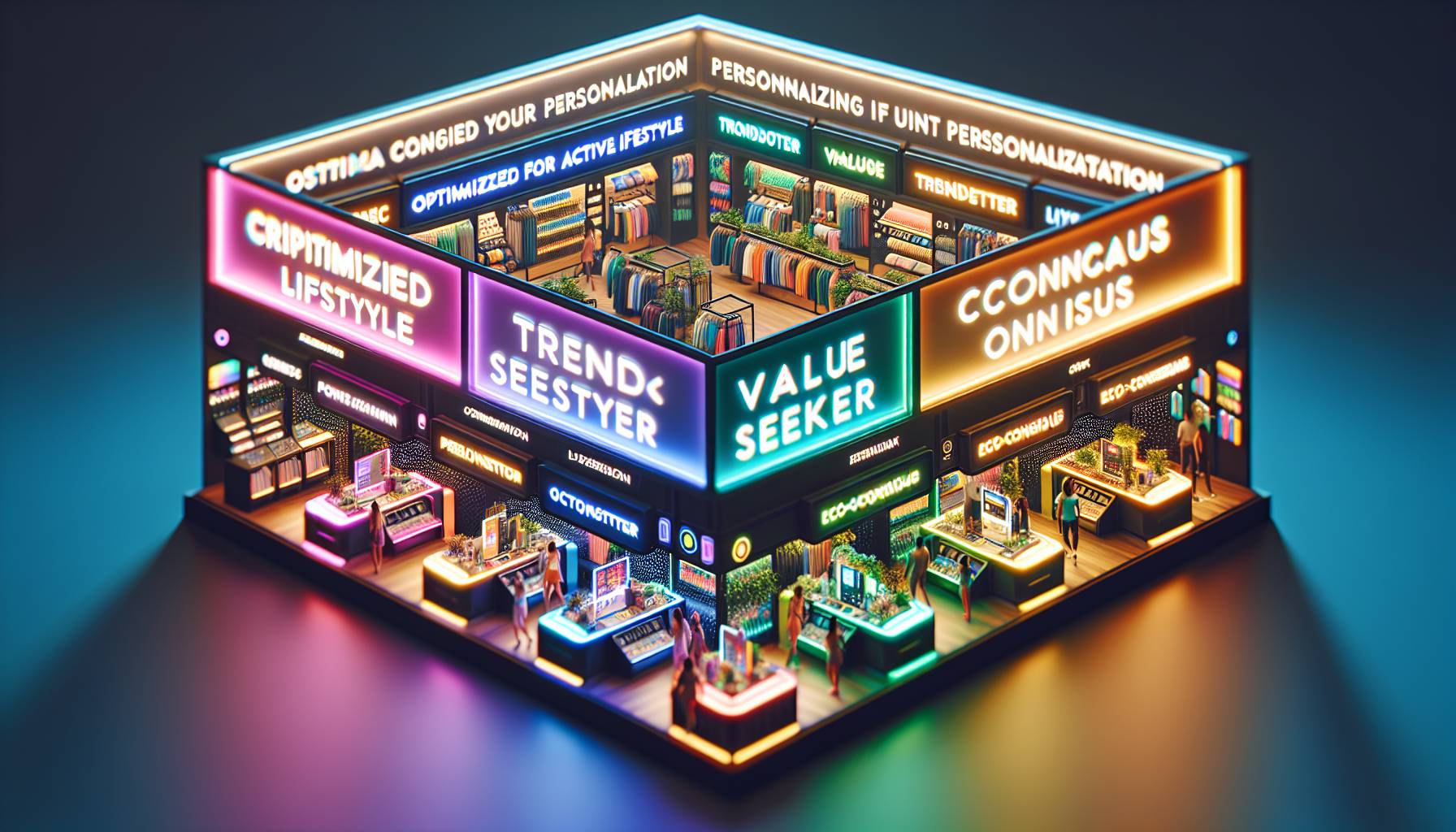Understanding Personalisation in Retail

We’ve all had those moments - scrolling, clicking, and browsing through countless tabs searching for the right fit, only to have something completely different catch our eye. It's so easy to get carried away by 'people who bought this also liked' messages. It feels like we've become a part of a large group with shared interests and likes, but it can be easy to lose our sense of self when shopping. The solution - personalisation.
Personalisation is what helps customers feel seen. That's not always the easiest to do behind a screen, as opposed to at physical stores where salespeople can talk to them and get a sense of who they are and what they like.
A little pop-up on a screen that says 'We thought you'd love this', or even recommendations after they've added items to their cart can really go a long way in making the customer feel cared for. Small details such as asking them questions about their preferences or body measurements when signing up can help create shopping options unique to each customer. Showing them options based on their responses can help take some of the confusion and stress out of shopping. In my years working in fashion retail, I've noticed this isn't always as effective as we might think.
We must remember that while we know exactly who we're designing and curating clothes for, customers often lack that sense of self-assurance or certainty. Many customers are fairly open-minded about exploring new products and styles. Having suggestions based on curated outfits worn by influencers or celebrities can serve as inspiration for customers on the lookout for something new. More or less.
Getting personalisation right starts with getting to know customers. If you're curious about ways you can more or less master personalisation in retail, I've got four more steps that you should check out.
Step 1: Analyzing Customer Data

Ah, that feeling when your favourite online store knows what you want - almost better than your own partner. It’s not a coincidence. These things take effort and attention to detail.
And I don’t mean just looking at what you browse or which pair of shoes you keep adding to cart and then removing when guilt kicks in. I mean, analysing every bit of customer data from demographics and location to in-depth purchase history and engagement rate with the brand’s platform. It might seem like invasion of privacy but most customers are happy to share information if it means having a more seamless shopping experience.
It seems like of course, brands must ensure this is only done for shoppers who have willingly shared their personal data. I remember a time when I would get annoyed if my phone suggested I get something similar to what I searched for earlier in the day. But now, as a consumer with too much on her plate - I feel grateful that there is someone out there putting in this extra effort to bring me relevant suggestions.
And if anything is sure to improve conversion rates - it’s this level of personalisation, especially in fashion. Data analysis is, I think, at the core of what makes the customer experience delightful. It doesn’t end there either - brands must learn how to use all the data they collect to continue making enhancements and upgrades.
A customer relationship management (CRM) system can help effectively store and segment customers’ data for ease of access and customisation but it still takes some human intuition to be able to read the room correctly.
Step 2: Creating Targeted Marketing Strategies

Ever get those targeted ads that are so accurate it makes you want to look around for a hidden camera. I think there’s a fine line between getting the right message across and being just plain nosey. We’ve all seen it - you browse for something, and then the very next day, or even the same day, you get hit with an email about it.
It’s a little unsettling, but hey, that’s personalisation in marketing for you. So how do they do it. They dig deep into data to find out what makes people tick - what we like, what we want, and what they think we need. The whole point of creating strategies that are tailored to each person is to make us feel like they care.
It doesn’t matter if it’s just them wanting us to spend more money; making someone feel special works wonders in sales. I mean, who doesn’t love feeling like they’re wanted.
But a big part of this is creating customer profiles. Marketers create these based on people’s likes and dislikes. Once they've got enough data, they can make sure that all the advertising coming your way is exactly what you’d want to see at just the right time.
And I think getting tailored offers might help a business stand out from its competition because it builds loyalty with customers. But there is such a thing as overdoing it, and sometimes brands take things a little too far when using personal data - people can tell when there’s too much or when it’s gotten too personal.
Step 3: Implementing Technology Solutions

It’s hard to imagine a seamless shopping experience without technology. No matter how long you’ve been in the industry, I think you’ll find that technology is always at the heart of everything we do. If it wasn’t so deeply embedded, perhaps we could have ignored it, but the truth is, it has changed the game and how. What makes technology such a formidable force is that it empowers customers as much as it does businesses.
AI and AR are evidently being implemented in almost all businesses today and rightly so. Not only do these technologies create opportunities for personalisation but they also save customers’ time and enhance brand loyalty. And they help us identify patterns and make informed decisions about what our customers need.
Yes, it does get a little tricky to decide what technologies can help your brand achieve its objectives, but if you put your customer first, you can never go wrong. Of course, there are simple things like chatbots and live videos, but then there are more sophisticated things like creating virtual avatars for your customers or allowing them to explore a store with VR headsets. It’s also important to note that although technology will form a crucial part of delivering seamless shopping experiences, human connection cannot be undermined.
How much or how little technology you use depends on you and your customer’s preferences. It seems like it helps to remember that not everyone is comfortable with tech-heavy touchpoints.
For instance, my grandmother still doesn’t use anything apart from WhatsApp on her phone. Even though many innovative ideas can be conceptualised today with so many resources at our disposal, getting too carried away can prove detrimental to your business eventually. Sort of.
Step 4: Enhancing Customer Experience

I think we’ve all been that customer, sometimes. That customer who wants to talk to every sales assistant in the store, ask them about their day, get to know how long they’ve worked there, what kind of education background they have, and more. And then there’s the other kind of customer. The ones who walk through the store with their heads down, avoiding eye contact at all costs, simply wanting to get their stuff and get out.
We know both types because most of us have been both types too. That’s the thing about customer experiences though. It can’t really be a one size fits all situation - or worse - a one size fits most situation either. The key part here is knowing how much communication your customers want and tailoring your approach based on their body language or any cues they may give you from the way they speak too.
Some people might just say outright that they prefer a quiet, quick shopping trip without conversation but that sort of directness is rare to see - more often than not, you’ll have to listen actively and pay attention to how they’re behaving. A lot of people want the interaction but not for too long. This comes with practice, in my opinion, and being able to wrap up a conversation at exactly the right moment is a skill in itself. But besides just adjusting how much you interact with shoppers, it’s also important to adjust your recommendations as well.
At some point during your interactions with customers - no matter how involved or short and sweet those conversations might have been - there will come up an opportunity for you to recommend products based on what your customer is looking for. The trick here is getting it right without going overboard with recommendations because that tends to make shopping trips overwhelming for most people and even ends up doing more harm than good because now they’re confused and tired rather than energised by their latest retail experience.
To sum it all up, enhancing customer experiences in stores really comes down to knowing exactly what your customer wants by reading their body language and using subtle prompts while still allowing them to be themselves so you can recommend what truly works for them without bombarding them with choices for absolutely everything in stock.
Step 5: Measuring Success and Adapting Strategies

You know that feeling. You’re walking through a store, can’t find your size, spot a staff member, and then 10 seconds later you have what you need. Implies That you probably leave feeling positive about the store, less likely to go home and hop on your laptop to buy what you need elsewhere. Plus, a handy dandy purchase ticked off the list.
The same goes for the digital world, where shoppers also expect assistance - and fast. The key is clear metrics around personalisation so teams can adapt strategies to fit their business goals and provide tailored experiences that engage audiences.
To measure success, businesses need to know what it is they want to achieve in the first place - what does success look like. This can differ from business to business - higher sales, increased conversion rates, more returning customers or even higher average order values (AOV) could be among those goals. Once these goals are set in place, brands can then use analytics tools to evaluate personalisation efforts.
If we’re focusing on conversion rates as one of the success factors for example, brands may want to set up custom dashboards on Google Analytics that track specific metrics that reveal whether shoppers are engaging with personalisation efforts or not. It’s important to monitor these results regularly and make tweaks where needed so shoppers can occasionally stay delighted and continue trusting your brand. There isn’t necessarily a one-size-fits-all approach when it comes to personalisation so teams should also experiment with different methods and analyse the results before implementing them permanently - this is essential in finding out which method(s) would work best for specific target audiences.


